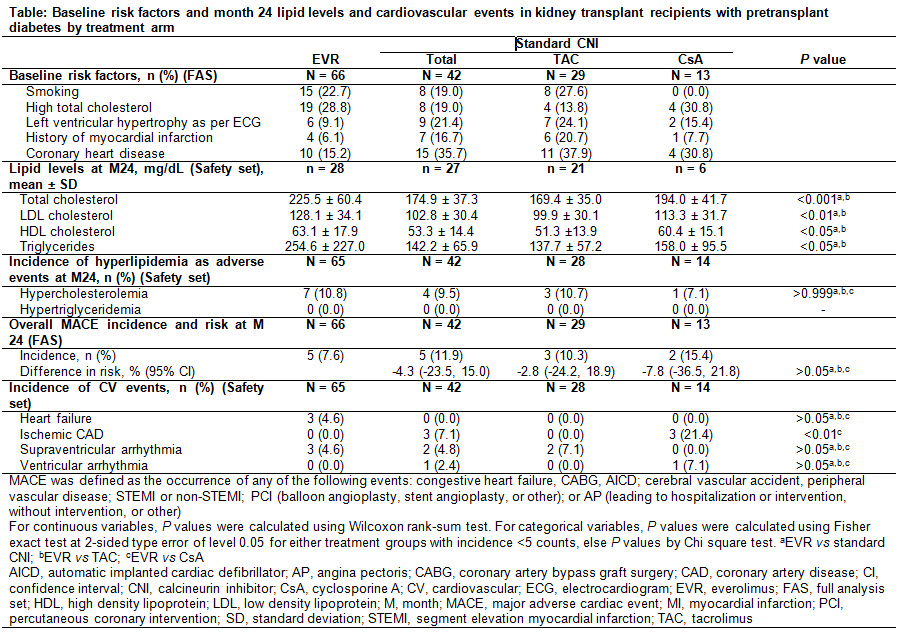Lipid Abnormalities and Cardiovascular Events After Early Conversion to Everolimus in Kidney Transplant Recipients with Pretransplant Diabetes: 24-Month Analysis from Elevate Study.
M. van der Giet,1 J. de Fijter,1 F. Oppenheimer,1 G. Russ,1 P. Lopez,2 G. Bader,2 J. Cruzado,1 H. Holdaas.1
1ELEVATE Study Group, Berlin, Germany
2Novartis Pharma AG, Basel, Switzerland
Meeting: 2017 American Transplant Congress
Abstract number: D132
Keywords: Immunosuppression, Kidney transplantation, Lipids, Risk factors
Session Information
Session Name: Poster Session D: Kidney: Cardiovascular and Metabolic
Session Type: Poster Session
Date: Tuesday, May 2, 2017
Session Time: 6:00pm-7:00pm
 Presentation Time: 6:00pm-7:00pm
Presentation Time: 6:00pm-7:00pm
Location: Hall D1
PURPOSE: Pretransplant (preTx) diabetes is an independent risk factor for cardiovascular (CV) events, and posttransplant (post-Tx) hyperlipidemia further increases CV risk. To analyze the influence of preTx diabetes on CV outcomes, a 24-month (M) analysis of lipid profiles and CV outcomes in diabetic kidney transplant recipients (KTxRs) from the ELEVATE (NCT01114529) study, receiving everolimus (EVR) or standard calcineurin inhibitor (CNI) regimen, was performed.
METHODS: In this 24M, open-label, multicenter study, KTxRs were randomized at 10-14 weeks post-Tx to receive EVR (N=360; C0: 6-10ng/mL) or continue standard CNI regimen (N=357; C0: tacrolimus [TAC] 5-10ng/mL/cyclosporine A [CsA] 100-250ng/mL). Total-, high-density lipoprotein (HDL)-, and low-DL (LDL)- cholesterol (C) and triglyceride levels and incidence of CV events, including major adverse cardiac events (MACE), were assessed up to M24.
RESULTS: A total of 66 and 42 patients in EVR and CNI arms had preTx diabetes, respectively. Within CNI arm, 29 and 13 patients received TAC and CsA, respectively. High total-C (28.8%) and coronary heart disease (35.7%) were the most prevalent baseline CV risk factors in EVR and total CNI arms, respectively (Table). At M24, all lipid levels were significantly higher in EVR vs TAC arm (P<0.05), but not between EVR and CsA arms. While hypertriglyceridemia was absent, hypercholesterolemia events reported as adverse events were comparable between arms (P>0.999). Overall MACE incidence was numerically lower in EVR (7.6%) vs TAC (10.3%) and CsA (15.4%), and incidence of ischemic coronary artery disease was significantly lower in EVR vs CsA arm (0.0% vs 21.4%; P<0.01). Other CV events were comparable between arms.
CONCLUSION: Lower frequency of CV events despite higher lipid abnormalities in EVR vs CNI arms indicates that hyperlipidemia with EVR-based regimen may not increase CV risk in KTxRs even in presence of preTx diabetes. Nevertheless, follow-up beyond 24M is required to establish the long-term benefit of EVR in these patients.
CITATION INFORMATION: van der Giet M, de Fijter J, Oppenheimer F, Russ G, Lopez P, Bader G, Cruzado J, Holdaas H. Lipid Abnormalities and Cardiovascular Events After Early Conversion to Everolimus in Kidney Transplant Recipients with Pretransplant Diabetes: 24-Month Analysis from Elevate Study. Am J Transplant. 2017;17 (suppl 3).
To cite this abstract in AMA style:
Giet Mvander, Fijter Jde, Oppenheimer F, Russ G, Lopez P, Bader G, Cruzado J, Holdaas H. Lipid Abnormalities and Cardiovascular Events After Early Conversion to Everolimus in Kidney Transplant Recipients with Pretransplant Diabetes: 24-Month Analysis from Elevate Study. [abstract]. Am J Transplant. 2017; 17 (suppl 3). https://atcmeetingabstracts.com/abstract/lipid-abnormalities-and-cardiovascular-events-after-early-conversion-to-everolimus-in-kidney-transplant-recipients-with-pretransplant-diabetes-24-month-analysis-from-elevate-study/. Accessed December 18, 2025.« Back to 2017 American Transplant Congress
